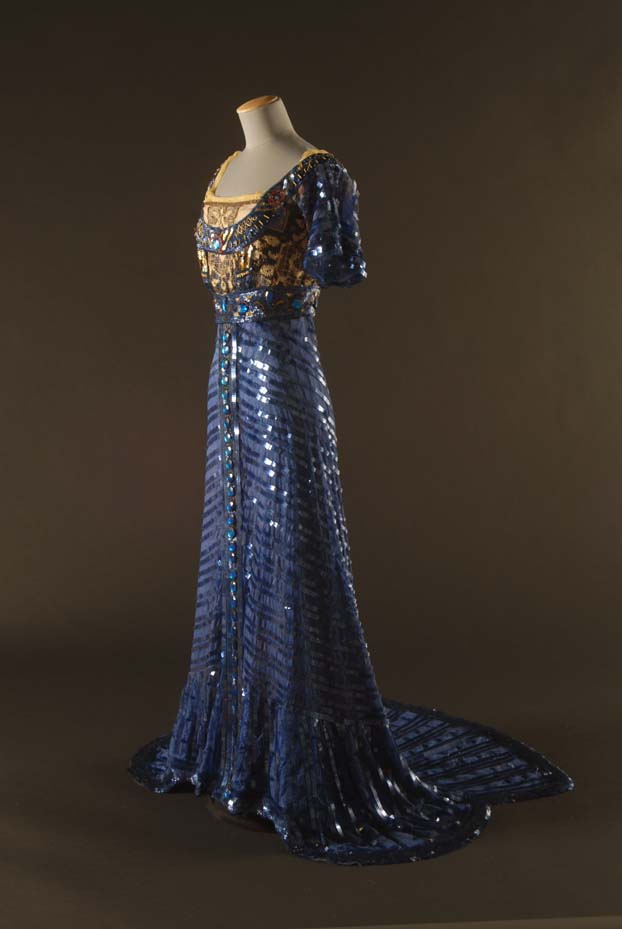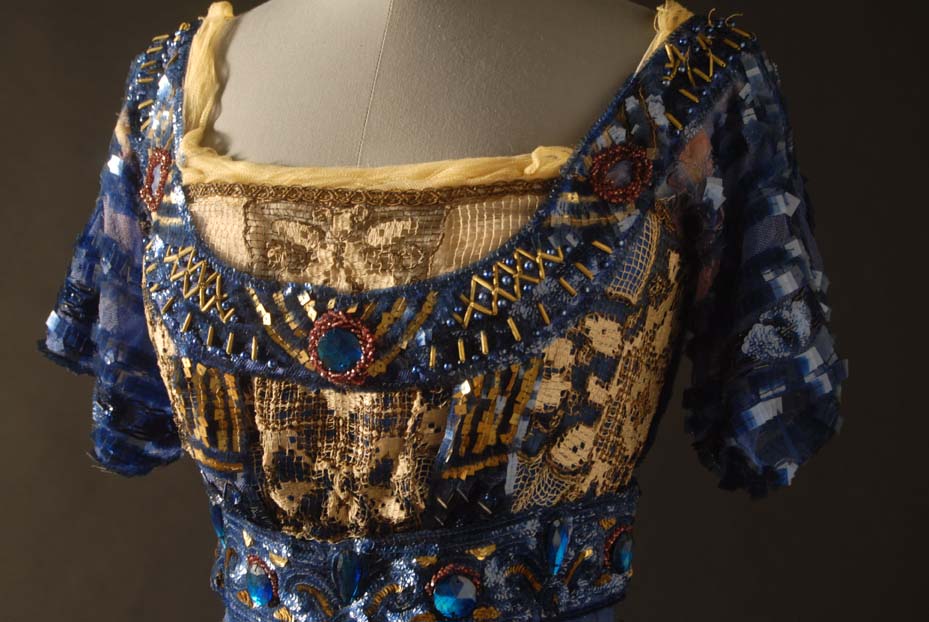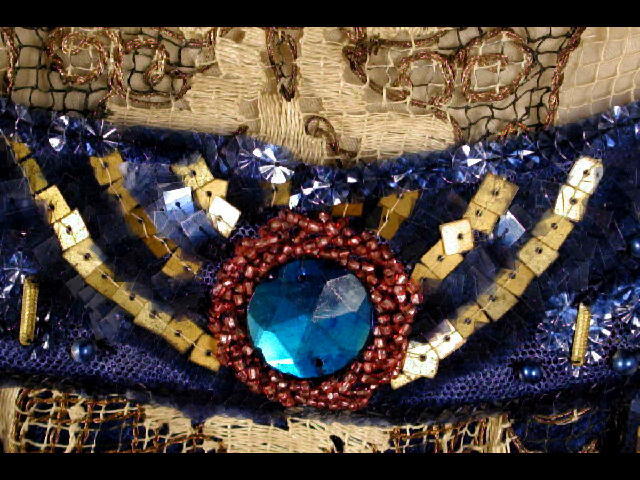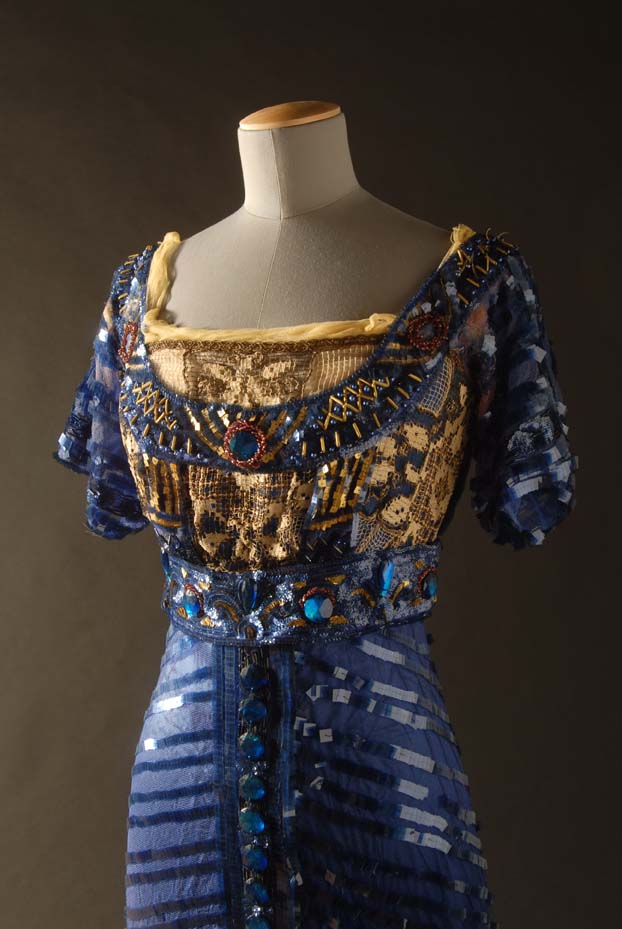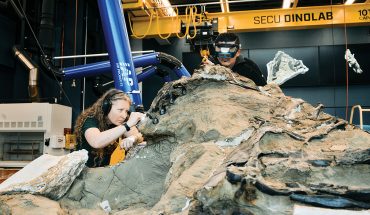A Callot Soeurs evening gown from the early 1900s offers studies in history, craft, anthropology, and culture.
by Hampton Williams Hofer | photos courtesy of the Gregg Museum of Art and Design
In the summer of 1909, a young woman wore an electric blue satin gown to an evening ball. It was adorned with a mesh overlay of iridescent sequins and glass beads, the intricate work of renowned French designers Marie Gerber, Marthe Bertrand, Régine Tennyson-Chantrelle, and Joséphine Crimont, known collectively as the Callot sisters. Creators of the label Callot Soeurs, these women were dubbed by American Vogue in 1916 as “foremost among the powers that rule the destinies of a woman’s life.”
“I can’t even imagine what it might have looked like in the low light of an evening event in the early 1900s,” says Jordan Cao, assistant registrar of the Gregg Museum of Art & Design in Raleigh. “It really is such a sight, with its deep, rich color, sparkling sequins, twinkling beads, and delicate lace.” On the interior waist stay of the dress, the words “Callot Soeurs PARIS” are woven into the ribbon, along with a stamp: “ÉTÉ 1909.”
Decades later, another set of sisters, Susan Biggs and Myrta Spence, discovered that blue Callot Soeurs gown in a trunk in their mother’s attic in eastern North Carolina. They donated it to the Gregg in 2003, where the gown remains in the permanent collection. Conflicting memories about who exactly purchased and wore this dress have clouded its history, so while the particular event to which it was worn — and by whom — remains unknown, the staining and wear under the arms bear witness to the fun it saw that summer.
The dress came into the collection at the Gregg when Mary Hauser — now the museum’s registrar and associate director — was still in graduate school. When it first arrived, she did preventative work to stabilize some fragile components: securing loose threads and adding supporting material behind degraded netting on the arms.
“Investigating the inner workings of a garment from another era or tradition teaches you to notice the details and intricacies of clothing and to question your assumptions about how things are made, what materials and methods are used, and why,” Hauser says. Where does this snap attach? How would the wearer feel in the garment? Could she put it on by herself or would she need help? If the garment has sleeves, why is it also boned? “You learn to become an investigator,” she says, “working backwards from the evidence in front of you to understand the garment and its story.”
Once a small visual arts center intended to exhibit art reflecting the curricula of North Carolina State University, the Gregg is now a museum with more than 35,000 objects in its permanent collection on Hillsborough Street, all of which are used for research, teaching, and preservation. It boasts the largest collection of outsider art in North Carolina, as well as everything from carved Native American kachina dolls to NASA photographs. But textiles are a specialty, from embroidered Japanese dragon robes to batiks from Indonesia to 18th-century hand-stitched quilts to 1980s prom dresses from the United States.
The Callot Soeurs evening gown shines among its comrades at the Gregg, but beyond its beauty, it’s a tool for learning at the university. “I think people are often surprised at the breadth of information to be gleaned from textiles,” says Cao. The College of Humanities and Social Sciences uses the dress to discuss religion, social systems, and technology. In considering styles across civilizations and geographies, the collection reveals intriguing cultural connections, says Cao: “You can trace trade patterns from India to the U.K. through paisley shawls, or look for American influence in Panamanian mola designs,” says Cao.
The gown’s empire waist and fishtail train represent a departure from the tight bustles and rigid corsetry that molded women’s fashion in the late 19th century. The Callot sisters were moving fashion forward, but influences of the past are all over this gown. “Just as we do today, designers of their era used themes, structural elements, and silhouettes that harken back to previous eras to invoke sentiments… or to present commentary or critique of the current time,” Hauser says. When the dress was created, a century after Napoleon’s invasion of Egypt, the French had developed a fascination with Egyptian culture that seeped into art, décor, and design. Lattice beadwork over the raw silk mesh at the neckline of the gown is reminiscent of the bead shrouds that covered mummy wrappings found in Egyptian tombs from the seventh and eighth centuries BCE — though the wearer of the gown likely had no idea that her neckline bore reference to ancient Egyptian funereal practices.
“The most striking aspect of this garment’s physical appearance is the sheer quantity of embellishment that nearly covers its surface,” says Hauser. “From square, round, and fluted celluloid sequins and iridescent glass beads to stamped metal ornaments and intricate filet lace with metal-wrapped thread accents, the piece is an endless display of masterful design, technique, and technological innovation.”
Daughters of a lace-maker, the Callot sisters made their own filet lace with a long blunt needle and thread, but they were also known for reusing fabrics from previous eras. The lace on the bodice of this particular gown is likely much older than the garment itself. The Callot Soeurs shop location at 24 Rue Taitbout in Paris — only a block away from the Paris Opera — no doubt contributed to the ornate and theatrical nature of their fashion creations.
Beyond the glitz of the dress is design mastery. “It’s the skirt that really makes a statement to me,” says Cao. For so long, dressmakers had used hoops and corsets to simulate a feminine shape that forced all bodies into compliance. This gown’s skirt relies on the wearer’s own form. “The central band of beading and the angled stripes of sequins certainly lengthen the body, but the overall form is dictated by the wearer’s hips and body shape,” says Cao. “A sheer layer holding the sequins rests over a satiny underskirt, allowing for natural movement in the sequin layer as the wearer walks, further highlighting her shape.”
The contrast of that extravagant outer layer with the more utilitarian inner layer creates a structural issue: how to support the weight of all those embellishments and still keep the wearer somewhat comfortable. The Callot sisters were serious pros, so the solution was both complicated and effective: the satin underskirt, reflective and luminous underneath, was backed with flannel to make it both soft and sturdy enough to hold the gown’s shape. That liner also protected the train from snagging as it swept the ground. The underskirt secures in the back, while the net layer is secured with a series of hidden snaps under the waist and center front trim, all to maintain the dramatic V-shaped pattern on the back of the skirt leading to the fishtail train.
Within the Colleges of Design and Textiles, the Gregg’s collection — and this dress in particular — offers a means of exploring materials and manufacture. The Callot sisters had more than just a cutting-edge sense of style: they required an understanding of physics and engineering to create a garment that was both comfortable and structurally sound. Its composition still impacts the way Hauser creates garments and costumes. “Even though I’ve worked with this gown for nearly 20 years, it’s still a favorite of mine,” says Hauser. “Not just for its overall beauty and elegance, and the balance of intricate detail and broad, sweeping shapes, but for the complex construction and materials that make all of those things possible.”
This article originally appeared in the December, 2021 issue of WALTER Magazine

